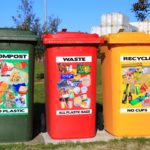 Curbside recycling can offset greenhouse gas emissions from landfill-bound waste, according to a recent study from the University of Florida.
Curbside recycling can offset greenhouse gas emissions from landfill-bound waste, according to a recent study from the University of Florida.
The authors examined the economic and environmental value of community recycling efforts and compared them to other climate change mitigation practices.
Their conclusion? Recycling offers a comparable or even superior return on investment to strategies like transitioning to electric vehicles or purchasing green power, which utilizes renewable energy sources. This highlights the importance of towns and cities continuing to provide recycling services to meet their climate goals.
“Eliminating recycling squanders one of the easiest opportunities for communities and citizens to help lessen the impact of climate change and reduce our demands on natural resources,” the researchers explain. “Recycling won’t solve the problem alone, but it is part of the puzzle.”
Rising costs
Rising costs have prompted towns and cities across the country to scale back or cancel their recycling programs. The study reveals that recent restrictions on recyclable materials imposed by major international markets have significantly contributed to the cost increase.
The researchers aimed to assess the cost disparity between recycling and regular garbage collection, while also examining whether the resale value of recyclables could sufficiently cover the program’s expenses. Additionally, they analyzed the role of residential recycling in reducing greenhouse gas emissions and preserving natural resources.
In 2011, during the most lucrative period for recycling markets, the annual cost per household in the United States was as low as $3. However, from 2018 to 2020, tighter restrictions and market disruptions caused by the COVID-19 pandemic led to recycling costs ranging from $34 to $42. Nevertheless, the study argues that despite the higher costs, the investment in recycling offsets the greenhouse gas emissions associated with non-recycled waste in landfills.
The authors propose that local governments restructure their recycling programs to focus on materials with the highest market value and the greatest potential for carbon offset. They identify newspaper, cardboard, aluminum and steel cans, as well as HDPE and PET plastic bottles, as higher-value materials that can enable recycling to become self-sustaining while reducing greenhouse gas emissions.
Public service
“Recycling is a public service provided by local governments to their residents, just like providing water, sewer, roads,” the researchers explain. “It is a service that does have an expense, but it always has. I would argue that it does not cost much when you compare it to other services we pay for, and when markets are good, you hardly pay anything.”
They also argue that both local and state governments could utilize policies that relieve the various costs associated with recycling, such as establishing a minimum amount of recyclable materials that manufacturers must use in packaging or products and placing some of the responsibility for recycling costs on the manufacturers.
“If we learn collectively to recycle better, we can reduce the costs to pretty much break even,” they conclude. “From an environmental perspective, that’s a good return on your investment.”